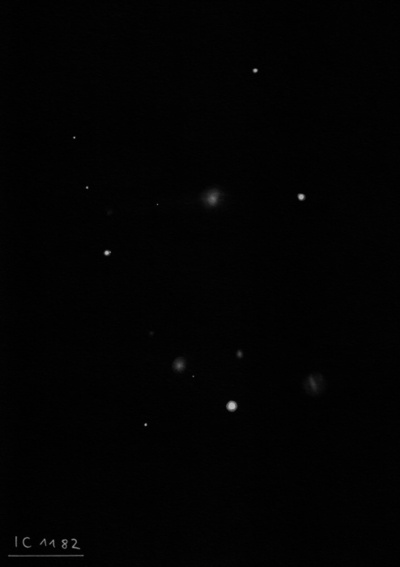
Stephane Javelle discovered IC 1182 = J. 1-372 on 11 Aug 1892. According to Harold Corwin in his Abell 2151 article, IC 1184 is a double or triple star 1.6' SE. The UGC questions if IC 1182 = IC 1184, which is does not.
400/500mm - 17.5" (5/13/88): very faint, very small, slightly elongated. Situated between two mag 14.5 stars 1.4' W of center and a mag 15 star following. Easier than IC 1183 2.1' SSE and NGC 6054 2.5' SW in AGC 2151. IC 1185 lies 5.4' SSE.
900/1200mm - 48" (5/5/16): at 488x; moderately bright, fairly small, slightly elongated ~E-W, contains a bright core that increases to the center. A mag 14 star is 1.3' W and a mag 17.8 star was occasionally visible [34"] east.
The brightest knot or condensation (likely a tidal dwarf galaxy) in the tidal tail was faintly visible 1.2' due east of IC 1182. It was generally visible as a very faint, small glow, slightly elongated E-W, ~10"x7". NED identifies this galaxy as IC 1182:[S72] d from the 1972 paper by Alan Stockton titled "Blue Condensations Associated with Elliptical and S0 Galaxies". This "knot" formed the western vertex of an obtuse isosceles triangle with a mag 17 star 40" NE and a mag 15 star 40" SE. The portion of the tidal tail extending directly out of IC 1182 (past the mag 17.8 star) was not seen.
48" (5/15/12): fairly faint to moderately bright, small, irregularly round, ~20" diameter, brighter nucleus. Located 1.4' E of a mag 14.3 star. Similar NGC 6054 lies 2.0' S. The jet extending out of the east side of the galaxy and the blue knots 1.2' E were not noticed (though not looked for).
Notes by Steve Gottlieb